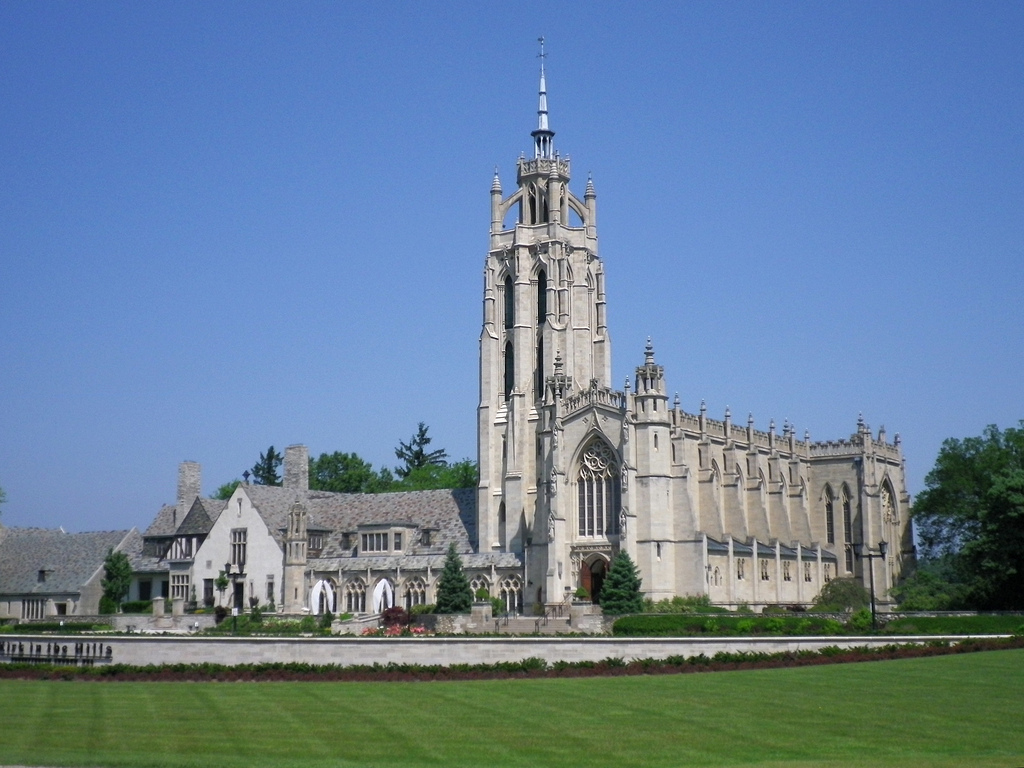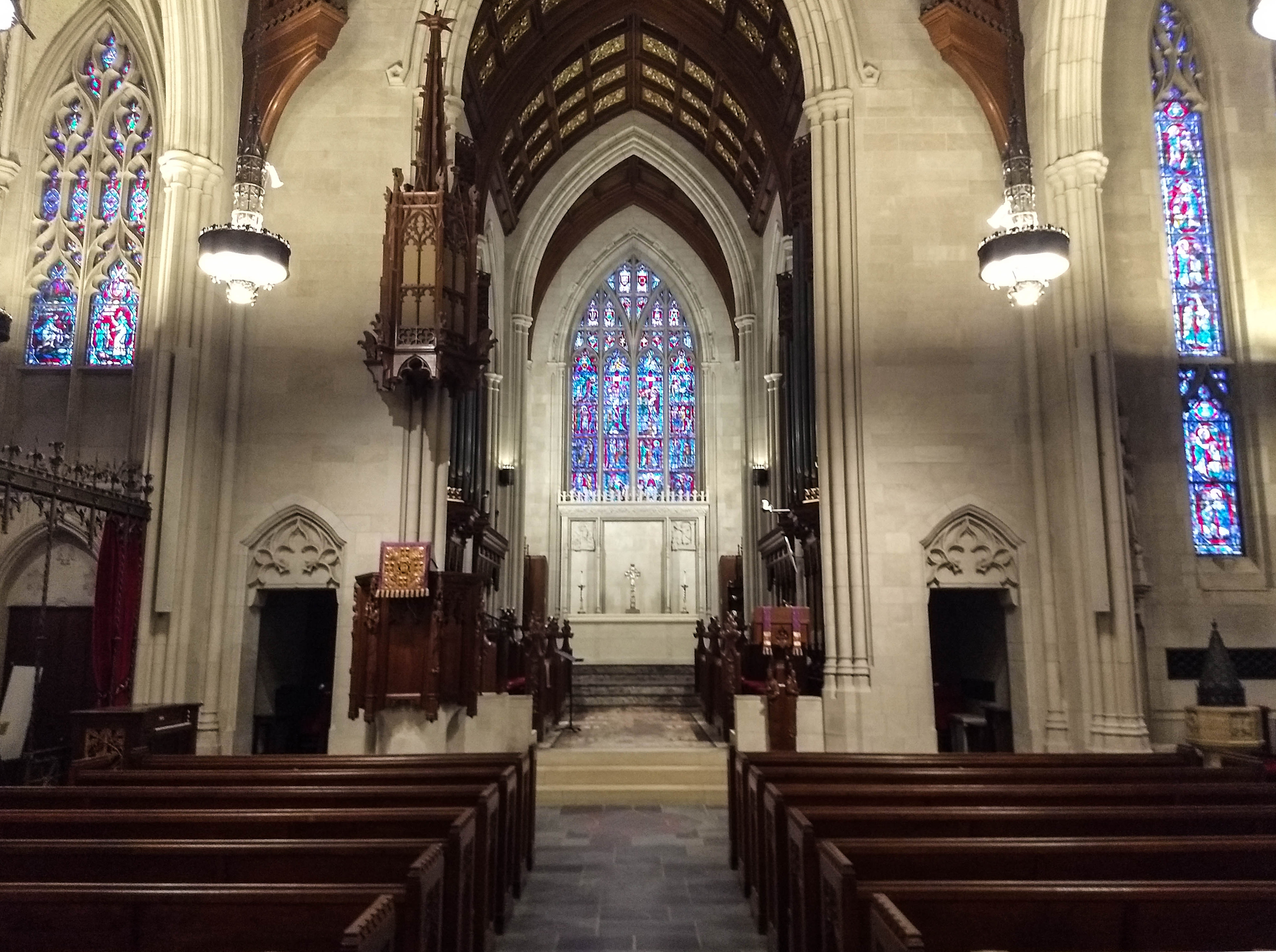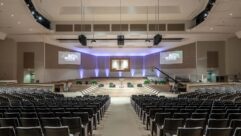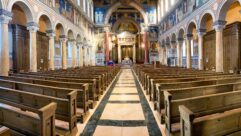

Bloomfield Hills, MI—April 2018… Patterned after Scotland’s 12th-century Melrose Abbey, Kirk in the Hills Presbyterian Church’s Gothic-style sanctuary was completed in 1965. Recently, the congregation sought to improve the sanctuary’s acoustics and replace its outdated, inadequate sound system. Chicago acoustics and AV firm Kirkegaard Associates was hired as the acoustics consultant and system designer, with systems integrators Advanced Lighting & Sound of Troy, Michigan, handling installation. The team based the new design on Renkus-Heinz IC24-RN digitally steerable line arrays, part of the ICONYX Gen5 series.
“Our company president, Joseph Myers, was the acoustic consultant,” discloses Kirkegaard Associates principle consultant Jonathan Darling. “I was the AV consultant, and we worked together on the project. The primary acoustic problem was that the space was too dry. The church has traditional services, with a medium-sized choir and a pipe organ, so one goal was to increase the reverberation time. We discovered that the ceiling panels were perforated metal, with absorption in the cavity behind them. Replacing the ceiling tiles increased the reverberation time in the mid band from about 1.6 seconds to about 2.1 seconds.” The new hard ceiling also provides supportive reflections that help the natural sound of the choir and organ reach the back of the nave, so amplification is only needed for spoken word.
The sanctuary has a narrow nave but is essentially free from obstructions, and the only balcony is for the organ, so Darling was able to cover the entire main sanctuary with one pair of Renkus-Heinz IC24-RN arrays. “With the old system, they needed mid-nave fills on either side, which produced some areas of high intelligibility but troughs and uneven performance in other areas,” Darling explains. “With one pair of IC24-RNs, we didn’t need mid-nave fills, which is better acoustically and cosmetically.”

Darling initially tuned the system with three beams, with the goal of delivering equal energy to every pew. He tuned the main beam quickly. The second beam and third beams were intended to fill the front pews. But congregation reaction and practical experience resulted in adjustments.
“People in the front had too much volume,” Darling details. “The system is mostly for speech reinforcement, and those front pews are getting a lot of acoustic output from the natural voice. So trying to bring the entire congregation to level SPL resulted in the front pews feeling overloaded. Bob Sullivan of Advance Sound & Lighting emailed me a Renkus-Heinz RHAON file, and I sent him back a file in which a single lobe covers the entire church. A second front downfill lobe is still there but turned all the way down, so it’s not used. If we’re too short of energy in the front, he can bring this lobe up to about -30 dB to fill in the front a bit.”
People in the rear pews had the opposite experience: They wanted a bit more energy. “The throw to the back is 96 feet, and usually I allow the SPL to tail off about 3 dB in the back of a space because I don’t want sound bouncing off the rear wall,” Darling elucidates. “But at Kirk in the Hills, that back wall is sort of diffusive, so we didn’t have a strong slapback. One of the advantages of Renkus-Heinz technology is that Bob Sullivan can email me the RHAON file, and I can make a recommendation without having to bring my whole tuning rig back on site or mechanically tilting the loudspeakers, as with a conventional speaker. In this case, I slid the acoustic center of the main beam upward a little bit higher and tipped the angle down a bit more, which allows us to drive to the back of the room and over the top of the front pews a little better.”
While Darling does take advantage of the ICONYX’ tuning features, steerable beams were not the main reason he chose ICONYX for Kirk in the Hills. “The primary reason we chose the IC24-RN is that the church is very concerned with aesthetics, and the low profile and shape of the ICONYX could be integrated better than other solutions,” he observes. “Advanced Sound & Lighting did a very good job mounting the speakers to keep them as hidden as possible. They also custom painted the arrays, including the mountings and cables, using a stone texture, not just a flat paint job.”

Another factor was that initially, Darling could not be certain what the final reverb time would be. “With ICONYX,” he notes, “I had room to overcome even a significant increase of reverberation time. We could adjust the IC24-RN in DSP as needed.”
The system’s Renkus-Heinz IC24-RN arrays and Yamaha TF1 digital console communicate using Dante, managed with a BSS Soundweb London BLU-100 DSP. A smaller system, driven by Dante-enabled Lab Gruppen amplifiers, fills the two sections of the transept, with a similar system filling the choir area. Dante-enabled wireless mics have been proposed for the future.
“ICONYX was a great idea to begin with, and each generation has been a step forward,” Darling asserts. “It’s nice to work with a product that you like but that every four or five years becomes substantially better. The new Gen5 product sounds even more natural than the previous generation. And it’s still affordable. At Kirk in the Hills, the installation was beautiful, and the system is working very well. We’re still making fine adjustments but the client is really happy.”










